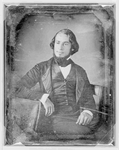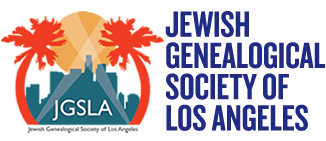1842-1862 information taken from the early journals (see below).
The Abraham Labatt Family
Their father, came to San Francisco in 1849. He was elected the first president of one of the two pioneer Western organizations, Emanu-El in April, 1851, and that same month he was elected one of the eight city councilmen who governed San Francisco. One of Abraham’s son’s, Samuel K., who had been born in New Orleans, came to San Francisco in 1850 where he opened a dry goods business with his brother Joseph, but soon returned to New Orleans where he was elected an officer of the Hebrew Benevolent Society there.
He returned to California in the spring of 1853 and settled in Los Angeles along with his brother Joseph.
Solomon Nunes Carvalho (pronounced Cavayo in Portuguese) was born in Charleston, South Carolina in 1815 into a Jewish family of Spanish-Portuguese descent. During the winter of 1853-54, Carvalho accompanied the explorer John C. Frémont on his fifth and final journey across the Rockies through the territories of Kansas, Colorado, and Utah searching for a railroad route to the Pacific. Carvalho produced more than 300 daguerreotypes on the trip, which were intended to be used in a report about the expedition. He worked as both a painter and a photographer. The daguerreotypes that Carvalho took on this expedition no longer exist. It is believed that the copy daguerreotype of an Indian village that came to the Library with the Brady collection was made from one of Carvalho’s daguerreotypes. Most of Carvalho’’s daguerreotypes were lost in a fire in New York City and the report was never written. Carvalho later wrote a book describing the journey. His journal is dated 1856 in which he describes his meeting in California with the Labatt brothers.

His photograph may be seen at:
http://memory.loc.gov/ammem/daghtml/dagport.html
http://www.jewish_history.com/WildWest/carvalho/index.html.
In 1854, just 200 years after the first Sephardim arrived in New Amsterdam, Carvalho opened a photographic studio in a building owned by the Labatt brothers, Samuel K. and Joseph, the only Sephardim in town at that time. He became one of the founding fathers of the Los Angeles Jewish community.
Bernard Cohn was one of the originators of Hellman, Haas & Company (now Haas, Baruch & Company, the well-known grocers), and a pioneer of 1856. During the late seventies and early eighties, he was a man of much importance, both as a merchant and a City Father, sitting in the Council of 1888 and becoming remarkably well-read in the ordinances and decrees of the Los Angeles of his day. Hippolyte Cahen (whose widow was a member of the Lazarus Stationery Company,) had an up-to-date general store at Anaheim; and Simon Cahen, son-in-law of Bernard Cohn, was similarly occupied in the Azusa district.
Harris Newmark (1834-1916), son of a modest Prussian Jewish merchant, sailed to America in 1853 to join his older brother in Los Angeles. He made a fortune in real estate, the wholesale grocery business, and hides and wools, becoming a leader in the local Jewish community and the city at large. Sixty years in Southern California (1916) begins with his description of Los Angeles as he found it; judges and lawyers, merchants and shops, churches and other landmarks. In the chapters that follow, Newmark organizes his materials chronologically and outlines his various mercantile partnerships and traces changing patterns of social life in Los Angeles, political factions, railroad construction in southern California, crime and vigilantism, the Chinese Massacre of 1871, and real estate speculations. In a more personal vein, he chronicles Jewish family life and philantropy.
Isaac Norton was one of the real pioneers of Los Angeles. That city was his home forty-eight years. He found it as a community still dominated by the Spanish and Mexican influences, with a large part of the population Mexican. His business enterprise contributed to the growth and development of the city, and no less important among the factors and influences emanating from his life were his civic loyalty and public spirit.
Norton, a Vermonter, who had first practiced law in New York, then migrated west, and had later been a prime mover for, and a member of, the first California Constitutional Convention, and who was afterward Superior Court Judge at San Francisco, was an excellent lawyer, when sober, and a good fellow. He came to the Coast in the summer of 1848, was made First Lieutenant and Chief-of-Staff of the California Volunteers, and drifted in 1852 from Monterey to Los Angeles. He joined Bean’s Volunteers, and in 1857 delivered here a flowery Fourth of July oration. Norton was the second County Judge, succeeding Agustin Olvera and living with the latter’s family at the Plaza; and it was from Norton’s Court of Sessions, in May, 1855, that the dark-skinned Juan Flores was sent to the State prison, although few persons suspected him to be guilty of such [p.48] criminal tendencies as he later developed. Norton died in Los Angeles in 1887; and Norton Avenue recalls his life and work.
Albert M. Norton, Los Angeles attorney and financier, was a son of the late Isaac and Bertha (Greenbaum) Norton, and in his personal career measured up to those standards expected of a representative of one of the oldest Jewish names in Southern California.
S. Tilden Norton, one of Los Angeles’ eminent architects, was a native son of California, and his professional work had a dignity and a certain quality that was among the distinctions readily recognized as the characteristics of “the California School” of Architects.
In 1853, M. Norton and E. Greenbaum sold merchandise at the southwest corner of Los Angeles and Commercial streets (when J. L. Jacob, an early Supervisor and City Treasurer, 1863-64 and Moritz Morris, Councilman in 1869-70, were competitors). In time, Jacob returned to Germany, where he died. Herman Morris, a brother to Moritz, was a local newspaper reporter. Jacob Letter was another rival, who removed to Oakland. Still another dealer in general merchandise was M. Michaels, almost a dwarf in size, who emigrated to South America. Casper Behrendt–father-in-law of John Kahn, a man prominent in many movements–arrived in 1851, was another Commercial Street merchant. Still other early merchants were Israel Fleishman and Julius Sichel, who had a glassware, crockery and hardware business; and L. Lasky, on Commercial Street.
Solomon Lazard and Maurice Kremer, cousins of about the same age, and natives of Lorraine, were associated in 1853 under the title of Lazard & Kremer, being located in a storeroom in Mellus’s Row, and I may add that since nearly all of the country development had taken place in districts adjacent to San Gabriel, El Monte and San Bernardino, travel through Aliso Street was important enough to make their situation one of the best in town. Lazard had arrived in San Francisco in 1851, and having remained there about a year, departed for San Diego, where it was his intention to engage in the dry goods business. Finding that there were not enough people there to maintain such an establishment of even moderate proportions, Lazard decided upon the advice of a seafaring man whom he met to remove his stock, which he had brought from the Northern town, to Los Angeles. He told me that he paid fifty-six dollars’ steamer fare from San Francisco to San Diego, and that the freight on his merchandise cost him twenty dollars a ton. Among his native friends, Lazard was always known as Don Solomon, and being popular, he frequently acted as floor-manager at balls and fandangos. Lazard is still living at the good old age of eighty-seven years. Kremer also reached here in 1852. In time, Timoteo Wolfskill, a son of William Wolfskill, bought Kremer’s interest, and the firm name became Lazard & Wolfskill. Each of these worthy pioneers in his day rendered signal service to the community–Lazard serving as Councilman in 1862; and I shall have occasion, therefore, to refer to them again. Abe Lazard, a brother of Solomon, who had spent some years in South America, came in the late fifties. Dr. E. M. Lazard is a son of S. Lazard. Still another early storekeeper at the quaint settlement was Max Lazard, nephew of Solomon Lazard, who later went back to France.
Mordecai Zeitoun. He was an entrepreneur in the Louisiana Purchase Exposition at St. Louis, Missouri in 1904. “”Papa”” as he was affectionately known, along with his daughter Rose arrived in Los Angeles during the closing months of 1904. probably in October or early November. They were followed by brothers Louis and David Bramy. David married Rose Zeitoun on March 6, 1906 and their son, Roger was the first known Sephardi to be born in Los Angeles on February 14, 1907.
